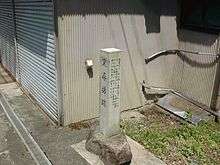Tōjinbō
| Tōjinbō (東尋坊) | |
| Protected Area | |
 Sandan Rocks and Byobu Rocks | |
| Country | Japan |
|---|---|
| Prefecture | Fukui |
| City | Sakai |
| Coordinates | 36°14′17″N 136°07′30″E / 36.238°N 136.125°E |
| Place of Scenic Beauty Natural Monument of Japan |
1935 |
| IUCN category | IV - Habitat/Species government Area |
 Location of Tōjinbō  Tōjinbō (Japan) | |
Tōjinbō (東尋坊) is a series of cliffs on the Sea of Japan in Japan. It is located in the Antō part of Mikuni-chō in Sakai, Fukui Prefecture. The cliffs average 30 metres (98 ft) in height and stretch for 1 km (3,281 ft).[1] The area is part of the Echizen-Kaga Kaigan Quasi-National Park.
Formation
The cliffs' rocks were originally formed 12 to 13 million years ago during the Miocene Epoch due to various volcanic activities, and were created by magma mixing with sedimentary rock to form columnar joints of pyroxene andesite containing Plagioclase crystals, Augite and Enstatite crystals in pentagonal or hexagonal shapes, which has been eroded by the sea.[1] The area received protection by the national government in 1935 as a Natural Monument.
Legends
One legend has it that a corrupt Buddhist priest from Heisen-ji (平泉寺), a local temple, so enraged the populace that they dragged him from the temple to the sea and, at Tōjinbō, threw him into the sea. His ghost is still said to haunt the area.
An alternate legend says that the name Tōjinbō comes from a dissolute Buddhist monk. According to the legend, a Buddhist monk named Tōjinbō, who was disliked by everyone, fell in love with a beautiful princess named Aya. Tōjinbō was tricked by another admirer of Princess Aya and was pushed off these cliffs. The legend says that ever after that time Tōjinbō's vengeful ghost would go on a rampage around the same time every year at this place, causing strong winds and rain. Some decades later, an itinerant priest took pity on Tōjinbō and held a memorial service for him. After that, the storms ceased.
 Sandan Rocks
Sandan Rocks Rosoku Rocks
Rosoku Rocks Byobu Rocks
Byobu Rocks 25 m (82 ft) high Oike
25 m (82 ft) high Oike
Suicides

Tōjinbō is also a well-known place in Japan to commit suicide. According to statistics, as many as 25 people commit suicide[2] by jumping off the 70-foot-high cliffs annually, a number which has risen and fallen with Japan's national economic hardships and unemployment rates. In the 2000s, Yukio Shige, a retired police officer, frustrated at having had to fish so many bodies out of the sea and the inaction of local authorities, began patrolling the cliffs for potential jumpers.[3] As of 2015 it was reported that he and the volunteers at the NPO he founded have saved over 500 lives.[4]. Although 14 people committed suicide there in 2016, in the next year, there has been no suicide for months. Yukio Shige says it is partly because many people come there to catch rare creatures of the mobile phone game Pokémon Go[5].
References
- 1 2 Fukui | Tojinbo. Japan National Tourist Organization. Accessed April 30, 2008.
- ↑ 派遣切られ東尋坊へ 履歴書の裏「これ以上は無理。」 December 25, 2008 (in Japanese) Asahi Shimbun Retrieved February 26, 2018
- ↑ Fackler, Martin (Dec 18, 2009), "At Japanese Cliffs, a Campaign to Combat Suicide", New York Times, pp. A6
- ↑ Calderwood, Imogen ‘We help them get their lives back’: Japan’s own suicide-catcher saves 500 lives in 11 years after dedicating his life to saving people July 28, 2015 Daily Mail Retrieved February 14, 2016
- ↑ Is Pokemon Go helping stop suicide at hotspot in Japan? April 6, 2017 BBC Retrieved February 26, 2018
| Wikimedia Commons has media related to Tojinbo. |